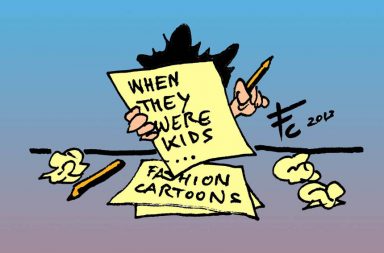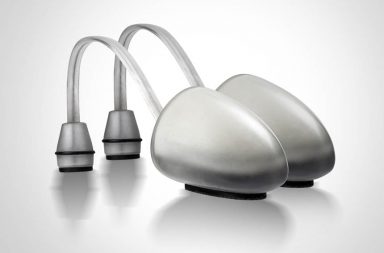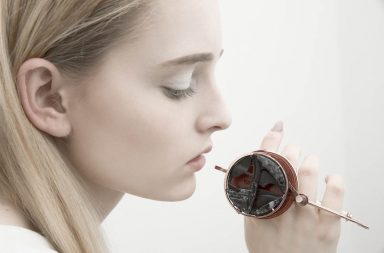Begüm Yildirim is one of those artists that you can’t get out of your head. Our fascination with her comes from her sensitive approach to art, which is deep, her craftwork, which is simply beautiful, and the way she constructs her pieces.

Begüm (Tukey, 1982) originally studied business administration but quickly realized that her path would be another, and so, like all brave people, she set out to find it. She finally settled on studies in fashion and accessories design and began working in the field and successfully participating in numerous design competitions. Recently, she graduated with a Master’s in Fashion Artefacts from the London College of Fashion with “Dictated”, her thesis collection made up of an assortment of bracelets, bags and bits and pieces of crystal, leather and metal.
Her take on fashion is quite similar to our own: Fashion is a vehicle to represent an idea, an interior conflict and a message, to create awareness and to change the world.
At So Catchy! Where Fashion Begins we spent some time with her and she had some interesting things to say about the world of fashion, an industry with such immense sociological power that never stops changing.

SO CATCHY!: When and why did you decide to change your path and study Fashion?
BEGÜM YILDIRIM: It might be a bit cliché but that was an interest coming from my childhood. Colorful and playful…right after graduation from university I definitely knew I had to change my life and go back to my dream of design. I was more interested in the power of clothes in the establishment of “identity” and the intimate and powerful relation between the clothes, body and the identity. Dressing is in essence such simple physical experience based on personal buying choices but in the end people communicate through clothes that are all surrounded with many ulterior messages regarding identity; such a powerful tool of social communication. Creative design processes impress me. I always had great interest to fabrics, materials and colors. Fashion design is the intersection of all those.
SC!: And why Fashion Artefacts?
BY: As a designer I have been looking for a seat for myself between conceptual design and art. When I first come across with LCF MA Fashion Artefact Programme I was extremely amazed by the works of alumni. It was an independent, interdisciplinary programme with a very wide perspective pushing the borders of creativity and innovation accompanied with high quality of making. The works were all offering a new perspective, saying something “new” with refined design aesthetics. The conceptual reference is well balanced with unique design language, innovating materials and production methodologies. By time, I realized my interest and commitment to objects more than I had to clothes. The philosophy of the course and “wide perspective” object design content were appealing for me. The link between fashion artefacts and “human” is so expressive too. I have seen that I could speak my words more successfully through fashion artefacts… This course was my dream of so many years.

SC!: Many people still don’t quite understand the concept of Fashion Artefacts. Since it’s so closely linked to art and the conceptual world, each creator seems to have their own definition. What’s yours?
BY: The meaning of “Artefact” is defined as “an object made by a human being”. That definition even says so much about Fashion Artefact. The term itself is expressive at all. For me, fashion artefact stands and acts as a bridge between art and design, integrating current manufacturing methodologies, technologies, and know-how with artisanal skills, handcraft and heritage in contemporary fashion context. An artefact objectifies conceptual statement and conveys a message and embeds the handicraft of its makers. It is a design object by carrying its internal features proposes a valuable object to stand lifetime and extends the fashion design context. I remember my course leader Dai Rees had defined the course as the platform that you will research and find out your own definition regarding what the “fashion artefact” is. My master experience was a journey to find my answer too. In addition to all technical evolvement, it was a very deep journey to myself, my identity as well. This was a very challenging but meaningful and valuable journey at all.
SC!: Your inspiration, according to your definition, seems to come from the complexity of humanity more than any other part of culture.
BY: My inspiration comes from human psychology and human nature and in the end I mostly find “something, a piece from somewhere, myself”. I become mostly emotional. I start with thinking and find myself in a flowing mind map, jumping from one notion to the other, lost in a mess of thoughts and emotions. I create a mess from thoughts and this is mostly chaotic. Then from that chaos I try to have an order, simplify, consolidate and objectify all these abstract experiences. And all through this path I have been passing, music is my muse. I may listen to the same song repeating hundred times again and again…

SC!: Tell us about Dictated. You say it is a design project developed based on self- experience of two reconstructive jaw surgeries… How did you come up with the idea?
BY: I had two major reconstructive jaw surgeries, some minor operations and seven years of orthodontics treatments. The process was really so much time consuming, physically painful and psychologically challenging. That was the time that I was almost at the final phase of treatment and I was questioning all the process I passed through. I wanted to work on this concept, research and get deeper about it. That would be the most sincere, interactive design journey that is made to my inner self as well. Anything you design has something from yourself and I think you could express, claim and propound something best in case you personally experienced it. This was my personal experience, which was so massive and intense, that I could speak and reflect through a design project.
SC!: You used some materials as glass, leather and metal. What has been the main challenge of working with such materials?
BY: Glass already itself as a material and the way I tried to use the glass were so challenging. I tried to design performative glass products linked to body, integrating functionality and dysfunction as well as conventional product features and abstractness as being sculptures at the same time. I wanted to keep and embed the traces of body, the veins, wrinkles, details of skin while body part is stabilized in a specific pose. The challenge was coming from that idea, keeping the body details in and developing an object, which is still performative. Glass parts, as being base forms for each design, especially the hot blown ones were super-fragile that development of further leather and metal parts and the assembly of them were seriously challenging. I designed glass pieces with “prosthesis” principle, which is a challenging feature too. Glass should have fit on body and each material; leather and metal should have fit on glass. To be honest I had nightmares but I collaborated with very kind, and experienced professionals during that challenge that helped me in the production of the pieces.

SC!: Could you synthesize your aim in one sentence?
BY: Dictated is developed with the intention to raise awareness regarding ideal beauty norms those dictating and manipulating self-body perception and to motivate the audience to question their perception regarding their bodies and attitudes towards it.
SC”: In your project, you wrote: “Could the artefacts orientate the audience to question, analyze and judge the significance of the body through a comparison of the status when the object is attached to body and in the absence of it? ” Tell us about the origin of this question.
BY: During my MA project I researched about cosmetic surgeries, operations women are practicing. The list that I came across was pretty much long to surprise me. Apart from all these interventions I realized that we had such experience in our every single day of life. We have high heels, tight jeans, uncomfortable cloths, and accessories harming and transforming our bodies as well. We had very specific gestures and manners to fit in all these objects. I was interested in the “instinct” the way we select the object to ornament our bodies, the intimate relation we settle between the object and our bodies and identity. Are we the ones trying to fit in all these objects to be more beautiful or our bodies formalizing all these objects? It was a cyclical flow between body and object. The form of a shoe or a bracelet is based on our body parts but we dictate our body parts to fit in them afterwards. We accept to suffer either. I see that, I interpret that cyclical correlation as an authority struggle. By developing conventional products linked with a specific body, my own body, I intended to objectify this conceptual approach. I wanted to appreciate the self-body, as it is. I intended to create the silhouette of related body parts via the void created when the product is not worn or attached. I tried to direct the audience to realize and judge, the significance of the “unique body” along with objects carrying the traces, texture and silhouette of related body part. What if the products would be just products without such powerful references of the body? I intended to question our inner instinct and the core motive behind wearing a product? Is it really a personal connection that we set through our own identity or the identity that is dictated to us, the identity believed to be the “ideal”? I tried to criticize this through settlement of a very powerful link between product and the related body.

SC!: You also said… “What if body refuses human-imposed perfectionist interventions such as plastic surgeries to keep uniqueness of its identity against these standardizing efforts?” …
BY: Actually this question was asked to the beholder kept remained unanswered intentionally because I want to criticize this. I have my own answer based on my own experience. After the first jaw surgery I had some complications and my body refused the treatment, final outcome was less than 40% success. I was trying to transform one part of my body; I was trying to idealize it. During my research I have seen the efforts of women to idealize themselves based on “images of other women”. Women transforming to other women… Such a standardizing effort? I just dreamed of a world in my mind, where all women are perfectly ideal, in the end looking like all each other. The uniqueness that each own would just be by the complications, thanks to complications… I assumed complications as the refusal of anatomy, the resistance of self-bodies, to keep themselves still unique, sole, different and special…
SC!: What´s the best part of what you do? And the worst?
BY: worst in the meantime. What I “try” to do is being in charge with creative processes and productive practices which is the best part I am in charge of. I am fond of this abstract phase, imagining, thinking and contemplating. Than all these ideas and novelties came to reality through a productive methodology and you have your “object”, something out of yourself. Sometimes the production phase might be painful but it’s worth it in the end. The experimentation phase has the most potential to meet yourself, your inner self by accidently, which is unbelievable. However this is the worst part of what I “try” to as well. These phases, for me almost all the time, are really painful. Stuckness, pushing yourself, fighting yourself, the confrontation you have with yourself… The expectation and desire to create something is really painful sometimes. I have one more “worst part” regarding this. This is ever worse than worst in case your freedom of creativity is restricted, directed and imposed or manipulated…

SC!: Fashion is in need of…
BY: The power of fashion on human psychology in respect of perception of body image and construction of social identity is extreme. There are current debates and studies regarding this for sure but I wanted to emphasize here in my answer as well; fashion is in need of empowerment and embracement of “self-identity” and appreciation of uniqueness of self-identities and self-images through sensible fashion communication strategies. More concern might be raised about the risk of sociological complications such as destruction in “self-identity and body-image perception” caused by the effect of fashion messages.
It is a huge industry and seems to be in need of more susceptibility, consciousness and responsibility for environment, more concern about sustainable fashion notion, labor working conditions and intellectual rights…
SC!: You cannot stop wearing…
BY: Sneakers.
SC!: What are you going to do next?
BY: to proceed with what I started during my MA project and deepen my research in my concept and the production methodology.
SC!: What would you like to do in the near future?
BY: I have just recently finished my graduate collection so I am open for opportunities; jobs, commissioned works, collaborations. I wish I could realize my own line in near future too. I would like to go on with further postgraduate studies, PhD. as well. I have pretty much things to count here that I would love to J.

SC!: What´s the future of fashion from your point of view?
BY: Fashion is a very challenging, competitive, consuming and demanding industry and it is getting fierce everyday. Creativity is limitless for sure but the expectation, the supply and demand balance are changing and the resources are running short. Fashion has the potential, the power and ability to re-conceptualize, re-establish and reposition itself again and again. According to my point of view, (and I wish it to be as) the new era might be the era of simplification, differentiation (appreciation of uniqueness, embracement of self- identity and personalized design), more concerned selection and conscious consumption. I see the interactivity as the dominant motive and the desire of “self” to have “active” role that I think; fashion will be interacting with the consumer much more closer to settle this upcoming personal link demand. Fashion might transform to be a platform for representation of uniqueness and self-identities through more interactive communication evolvement.
SC!: Define yourself in a few words…
BY: I would like to define myself through other’s (who knows me well) words to define me; I am said to be ambitious, patient, hardworking, idealist and productive.
CREDITS:
Header and first series:
Photographer: Ozan Kıymaç
Photography Assistant: Altug Poşul
MUA & Hair Styling: Samet Kılcı
Model: Rachel L. (NewModels Management Agency)
Studio: Look34 Istanbul
Second series:
Photo and Art Direction: Kati Turkina Faso
MUA: Porsche Poon
Hair Styling: Louis Souvestre
Model: Olga
Translation and Layout by Michael Padilla




